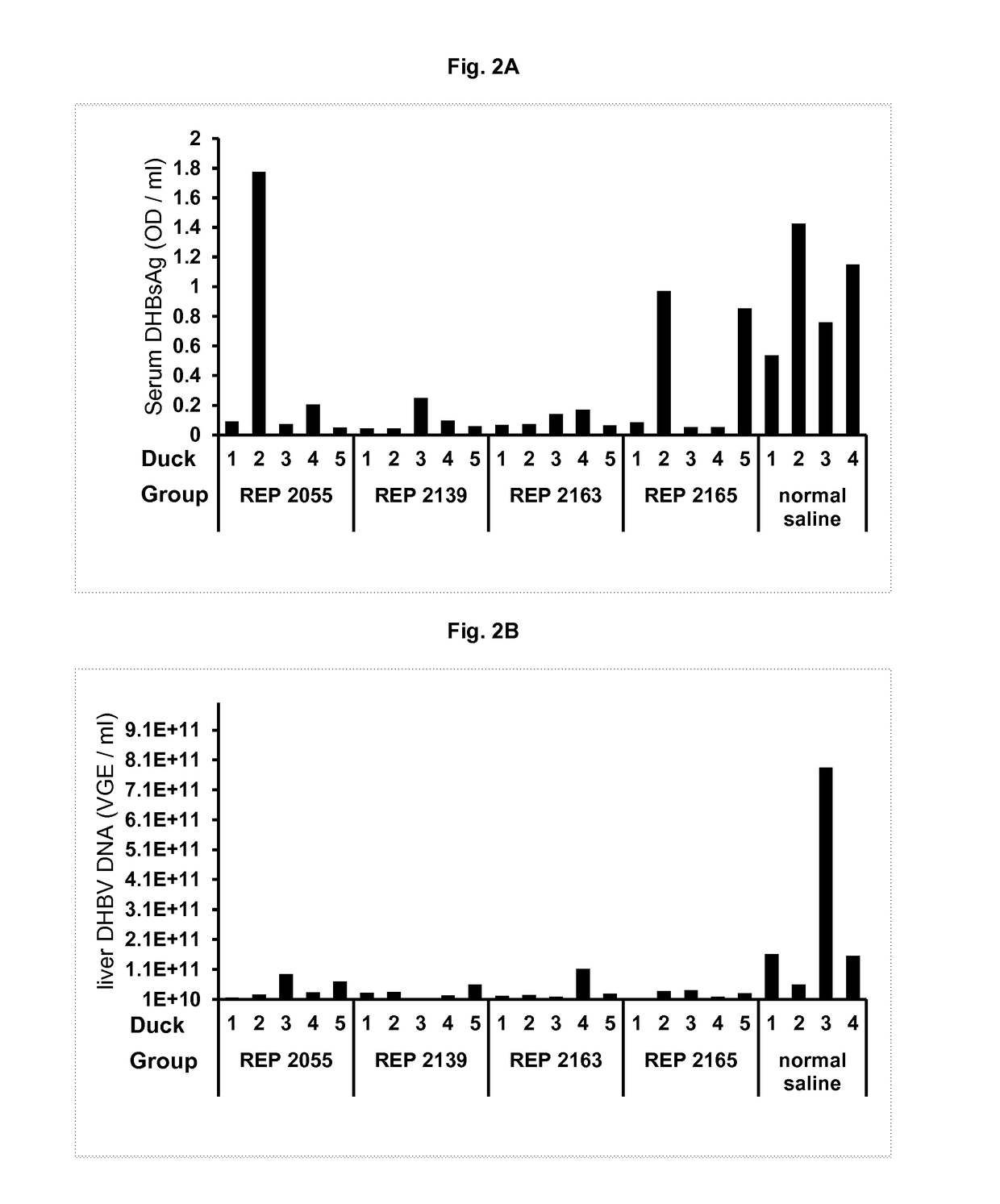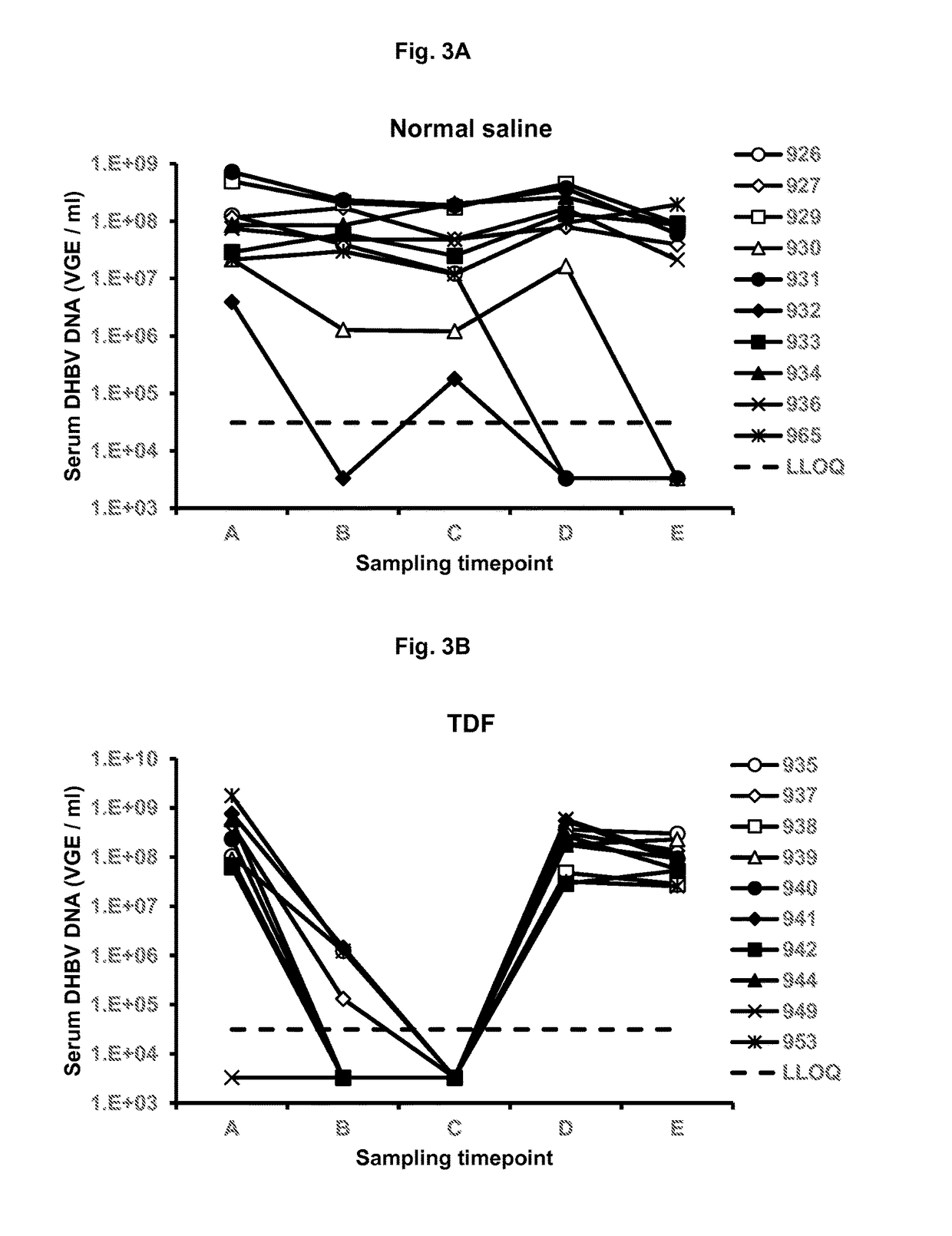Methods for the treatment of hepatitis B and hepatitis D virus infections
a technology for applied in the field of treatment of hepatitis b and d virus infections, can solve the problems of increasing the rate of progression of liver disease to liver cirrhosis, none of these is able to elicit a therapeutically effective immune response capable of providing durable control of infection,
- Summary
- Abstract
- Description
- Claims
- Application Information
AI Technical Summary
Benefits of technology
Problems solved by technology
Method used
Image
Examples
example i
Effect of Combination NAP / ETV Therapy on Serum HBsAg
[0176]A pharmaceutically acceptable formulation of the NAP REP 2055 (SEQ ID NO: 2) was administered to a patient with chronic HBV infection by once weekly IV infusion of 400 mg. The serum HBsAg response in this patient was monitored real-time each week using a qualified, on-site qualitative ELISA. This ELISA method is very sensitive to low levels of HBsAg but cannot accurately quantify any significant HBsAg concentration in the blood. Although no detectable reduction in serum HBsAg was observed using this HBsAg assay during REP 2055 monotherapy (FIG. 1, squares), this patient experienced a very mild (˜1 log) drop in serum virema (serum HBV DNA), indicating that some sort of antiviral response had occurred. Therefore, after 29 weeks of REP 2055 monotherapy, this patient received HBV polymerase inhibition therapy in addition to the existing REP 2055 therapy which consisted of 0.5 mg of entecavir taken orally every day.
[0177]Immediate...
example ii
Antiviral Effects of Various NAPs in DHBV Infected Pekin Ducks
[0180]Various NAPs comprising different nucleic acid modifications were tested in DHBV infected Pekin ducks to establish their antiviral activity. These NAPs are REP 2055 (SEQ ID NO: 2), REP 2139 (SEQ ID NO: 10), REP 2163 (SEQ ID NO: 11) and REP 2165 (SEQ ID NO: 13). Table 2 provides a chemical description of these NAPs.
[0181]
TABLE 2Description of NAPs used in Example IINAPSequenceOligonucleotide modifications presentREP 2055(dAdC)20Each linkage is phosphorothioated(SEQ ID NO: 2)REP 2139(A, 5′MeC)20Each linkage is phosphorothioated(SEQ ID NO: 10)Every ribose is 2′O methylatedREP 2163(A, 5′MedC)20Each linkage is phosphorothioated(SEQ ID NO: 11)Only the riboses in adenosine are 2′OmethylatedREP 2165(A, 5′MeC)20Each linkage is phosphorothioated(SEQ ID NO: 13)Every ribose is 2′O methylated exceptadenosines at positions 11, 21 and 31where riboses are 2′OH.dA = deoxyriboadenosinedC = deoxyribocytidineA = riboadenosine5′MeC = ri...
example iii
Antiviral Effects of NAPs in Combination with TDF and ETV in DHBV Infected Pekin Ducks
[0184]The antiviral effect of combined treatment with the calcium chelate complex of REP 2139 (REP 2139-Ca) and TDF or REP 2139-Ca and TDF and ETV in DHBV infected Pekin ducks was examined by assessing changes in the levels of serum and liver DHBV DNA during and after treatment by quantitative PCR. Infection of ducks was carried out as described in Example II except that treatment was started one month after infection. Treatment regimens were as follows:[0185]1) Normal saline given by IP injection 3 times per week for 4 weeks[0186]2) TDF, given 15 mg / day by oral gavage for 28 days[0187]3) REP 2139-Ca, given 10 mg / kg by IP injection, 3 times per week for 4 weeks.[0188]4) REP 2139-Ca and TDF (as dosed above)[0189]5) REP 2139-Ca and TDF (as dosed above) and ETV given 1 mg / day by oral gavage for 28 days.
[0190]Serum DHBV DNA was assessed pre-treatment (time point A), at day 14 of treatment (time point B...
PUM
| Property | Measurement | Unit |
|---|---|---|
| pharmaceutical composition | aaaaa | aaaaa |
| length | aaaaa | aaaaa |
| density | aaaaa | aaaaa |
Abstract
Description
Claims
Application Information
 Login to View More
Login to View More - R&D
- Intellectual Property
- Life Sciences
- Materials
- Tech Scout
- Unparalleled Data Quality
- Higher Quality Content
- 60% Fewer Hallucinations
Browse by: Latest US Patents, China's latest patents, Technical Efficacy Thesaurus, Application Domain, Technology Topic, Popular Technical Reports.
© 2025 PatSnap. All rights reserved.Legal|Privacy policy|Modern Slavery Act Transparency Statement|Sitemap|About US| Contact US: help@patsnap.com



